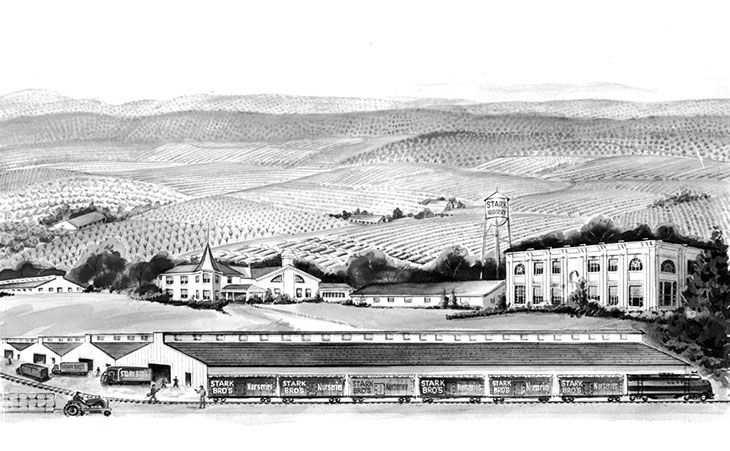Remembering 200 Years


Wikimedia Commons
1816
In 1816, James Hart Stark and a small band of pioneers migrated by covered wagon from Bourbon County, Kentucky to settle on the fertile western banks of the Mississippi. Little did James know that the apple-tree scions he carried in his saddlebags would one day launch an international nursery dynasty.
James Stark was skilled at the art of grafting to produce better fruit varieties, and demand grew quickly for superior trees he grew. The railroads opened the door to nationwide shipping, and soon, Stark Bro's was a household name.

Also during the year of our founding, volcanic ash from an eruption of Mt. Tambora caused lower temperatures worldwide, ruining crops on every continent. Fortunately, the trees planted that first year by our founder, James Hart Stark, survived the "Year Without A Summer."
1887
In 1887, Stark Bro’s first national advertisement appeared in Harper’s Magazine.

1893

The original Delicious apple was discovered in 1893, but the grower wasn't identified until 1894. He had entered the apples in a Stark Bro’s contest, but his nametag was lost. It wasn't until the following year, when he entered again, that his name was known: Jesse Hiatt, of Iowa.

1896

Stark Bro’s first color catalog was printed in 1896 and was the first color nursery catalog ever printed.
1914


In 1914, three apples shaped like the Red Delicious were sent to Stark Bro’s by A. H. Mullins of Odessa, West Virginia, but they were all yellow. It was a chance seedling with great keeping ability, and that was the Golden Delicious apple, introduced to the world by Stark Bro’s in 1914.

To see the first Golden Delicious apple tree in 1914, Paul Stark Sr. took a cross-country railroad trip, then rode horseback for 20 miles through the mountains to A. H. Mullin's home in West Virginia. Stark described the tree as having, "a tremendous crop of great, glorious, glowing golden apples!"
The Golden Delicious apple was an instant hit. The flavorful, crisp fruit was sold in many railroad stations, and was wildly popular with train passengers.
1925

In 1925, Paul Stark – a descendant of our founding family – signed Luther Burbank’s guestbook. His comment, "In appreciation of 35 years of co-operation and personal friendship" was a tribute to Stark’s respect and admiration for Burbank and his horticultural accomplishments.

1927

The "Golden Delicious" was a favorite of Queen Marie of Romania. On her widely heralded 1927 tour of the US, she visited St. Louis, where she first tasted it. At first the Queen declined to be photographed, but she was so enthused about the fruit that she invited the photographers to snap her picture, holding the apple.
1932
Stark Bro's was granted the first plant patent on a fruit in 1932 for the Stark® Hal-Berta™ Giant Peach. Since then, we have patented more fruit varieties than any other nursery.
1936
Lloyd Crow Stark was elected Governor in 1936. He then ran for State Senator in 1940 but lost in the primary election to Harry Truman by only 8,000 votes.

1938

In the spring of 1938, Paul Stark Sr. "experimented" with water-misting during a frost to protect tree buds. The practice is now standard procedure in orchards worldwide.

1944
Paul Stark Sr. was largely responsible for the famous Victory Garden program during WWII. In 1944, roughly 43% of the fresh vegetables consumed by the public were grown in Victory Gardens.

1956
In 1956, during his annual summer search for new varieties, Paul Stark Jr. found the Starkrimson® Red Delicious apple. He paid for it on the spot and it proved to be one of Stark Bro's most successful discoveries.

1961
Ginny Andrews started at Stark Bro's in 1961. In 1977, she wrote down her career goal: to "run a garden center someday." In 1981, she began to do just that. Ginny retired in 2009, after 48 years with the company. She still works at Stark Bro's Garden Center – a local retail store in Louisiana, MO – and is Stark Bro's longest-serving employee.
1974
Warehouse “N” burned to the ground in 1974, but left all of the immediately surrounding buildings untouched. Only nails and a dirt floor remained after the fire.

1994
In 1994 Stark Bro’s was sold to Foster & Gallagher, a horticultural catalog company that owned many other companies.
1999
In 1999, Clay Stark Logan (the last Stark president) and his brother, Walter, were the last two "Stark brothers" to run the company.

2001
During the summer of 2001, Stark Bro’s former parent company Foster & Gallagher went out of business. The bankruptcy left most of Stark Bro’s dedicated employees without a job. The few who remained knew that in order to save Stark Bro’s, they would have to save the current crop. A small but dedicated group, known as “The Budders,” took to the fields, grafting and budding every rootstock, without pay. But for this extraordinary group of people, Stark Bro’s might have perished.
Later that year, famous radio broadcaster Paul Harvey did one of his “The Rest of the Story” pieces about the Stark employees who volunteered to bud trees so the business wouldn’t be lost.
Also later that year, a bankruptcy auction determined a new path for this historical company, then 185 years old. Stark Bro’s was purchased by Cameron Brown and Tim Abair, and was once again under private-family ownership. It remains one of the oldest businesses in the United States.


